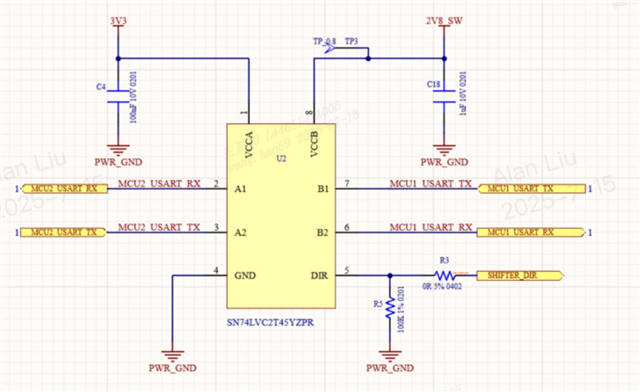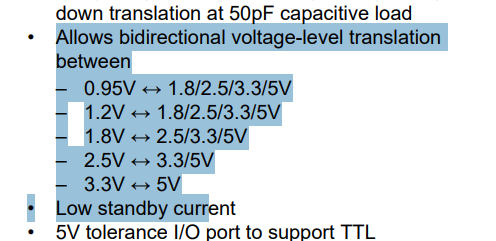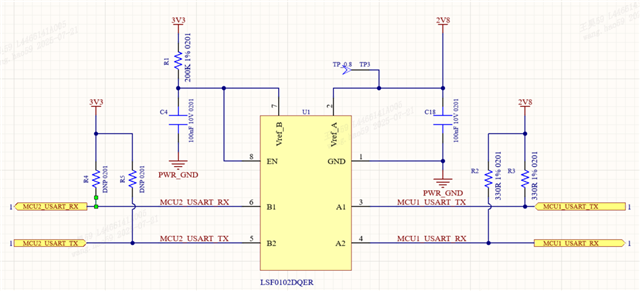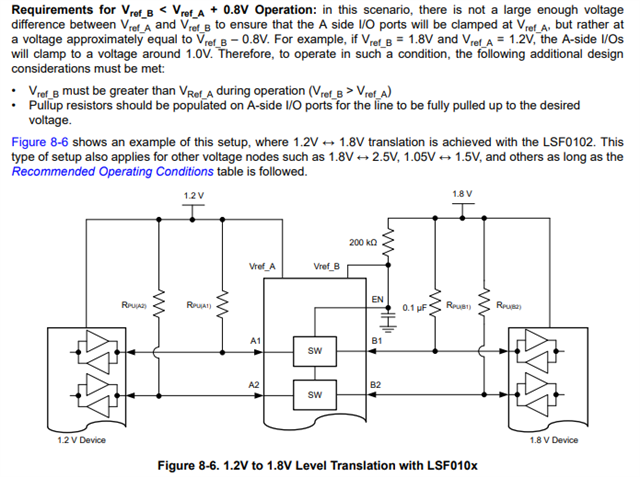Other Parts Discussed in Thread: TXB0102, LSF0002, LSF0102
Tool/software:
Hi team,
For the level shift between two MCU, the system need to config the DIR voltage level to determine direction before start shift?

This thread has been locked.
If you have a related question, please click the "Ask a related question" button in the top right corner. The newly created question will be automatically linked to this question.
Tool/software:
Hi team,
For the level shift between two MCU, the system need to config the DIR voltage level to determine direction before start shift?

Hello Kailun,
I would make all bypass capacitors have the same value. 100nF should be fine.
The LVC is a bi-directional translator meaning you can change the signal direction of the part. Essentially you can configure B-port to be an input or output. (same thing will apply to A-port).
See the truth table below

If DIR is Low, data will be translated from B-port to A-port. When DIR is High, data will be translated from A-port to B-port.
Regards,
Josh
Thanks Josh,
So customer need to adjust DIR voltage level first if they want to change the data direction right?
Thanks Clemens and Josh,
Customer's support need is data transfer between 2.8V MCU and 3.3V BLE.
The LSF do not support 2.8V.
Besides, TXB0102 require OE input sequence, but customer has to connect OE to VCCA or VCCB, cannot control the sequence.
Does TI has solution between 2.8V and 3.3V? And do not have requirement of OE sequence?

Hello Kailun,
Where do you see LSF doesn't support 2.8V? The voltages commonly used in the industry are displayed on the front page but those are not fixed. You can use LSF at 2.8V.
Regards,
Josh
Thanks Josh,
I thought it can only support below voltage before. btw, is there any different between LSF0002 and LSF0102? Which one is more suitable here?

These are just examples. All voltages between the minimum and maximum are supported.
The LSF0102 has an additional biasing circuit that allows somewhat higher speeds (which does not matter for UARTs).
Hello Kailun,
I agree with Clemens. Both have a similar architecture. LSF0002 removes the biasing circuit which allows the part to be offered in a smaller package.
Regards,
Josh
Hi Josh, Hi Clemens,
Thanks for your kindly support.
Please help to review below SCH that achieves 3.3V between 2.8V level shift. The 2.8V and 3.3V will be powered on at the same time.
Btw, do you have the data of power consumption in this condition? Thanks!

The sch refer the design here in datasheet that VrefB<VrefA+0.8V.

You do need pull-up resistors on the higher-voltage side.
The pull-up resistors on the 2.8 V side should be several kΩ.
You do need pull-up resistors on the higher-voltage side.
2.8V is lower-voltage side. Is that a typo? you mean lower side?
You do need pull-up resistors on the 3.3 V side.
The pull-up resistors on the 2.8 V side are not as important, and should have a higher value.
Thanks Clemens,
I am curious of pull up resistor, based on the description in datasheet, the Rpu=(3.3V-0.35V)/0.015A=196ohm, how it could be several kohm? Can you directly suggest a value of Rpu(B) and Rpu(A)? 3.3V - 2.8V.

Besides, customer is wondering the power consumption in TXB0102 and LSF0102, do you have related data in 3.3V-2.8V condition? Notice the continuous current will reach to 128mA, how could I understand this data, when this device will reach such power consumption?

For I²C, the total pull-up current (through the resistors on both sides) must not be larger than 3 mA. If your signals are not faster than 1 Mbps, your pull-up current should have a similar value.
Thanks Clemens,
The final question, how about the pull up resistor value?
I am curious of pull up resistor, based on the description in datasheet, the Rpu=(3.3V-0.35V)/0.015A=196ohm, how it could be several kohm? Can you directly suggest a value of Rpu(B1,B2) and Rpu(A1, A2)? 3.3V - 2.8V.

That example is for a different application; 15 mA is needed only for extremely high speeds.
Just try 4.7 kΩ on both sides, then check the waveforms with an oscilloscope and adjust accordingly.